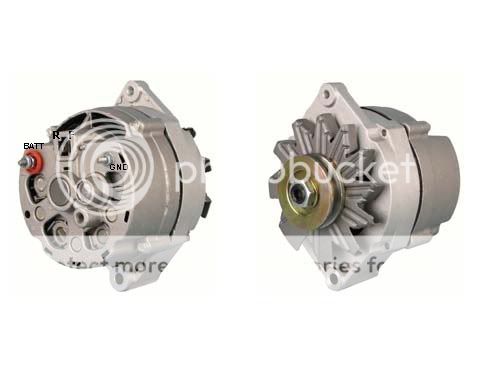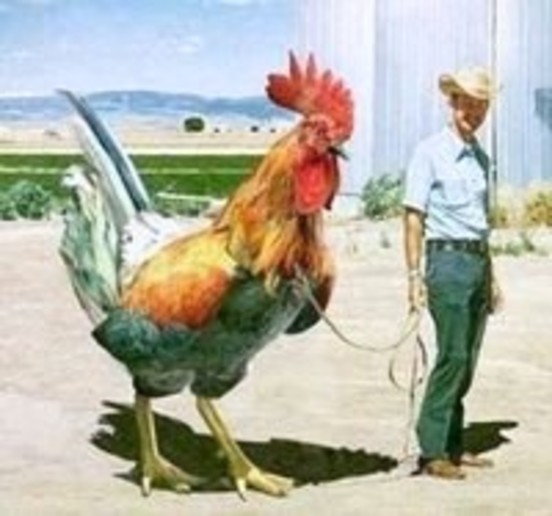Frontranger
Member
I'm adding some lighting to my 1972 diesel MF 135 that didn't come with it (turn signals, hazard flashers, and some off road lighting), and I have a question about the alternator.
A little background: my machine may have had a conversion from a generator to an alternator at some time, but I'm not positive about that. The wiring seems to correspond pretty well to an OEM MF drawing of an electrical system for a diesel WITH AN ALTERNATOR that I have. Also has a newer 4 post voltage regulator, not the 3 post kind that would have been installed with a generator. It runs great, is starting very well, even under the sub-zero conditions we've got here now. Some of the wiring has been up-graded somewhat (newer connectors at some locations, fuses added where they should be but not OEM, and all connections recently cleaned up too).
This puppy has what I think is a Delco-Remy 10DN alternator(exterior voltage regulator required) and for all I can tell, it looks to be much newer than what a '72 MF135 probably came with. By the ammeter, and everything else I can see, it seems to be working just fine. I have researched and investigated these alternators some and understand that the lowest output for the 10DN is somewhere around 37 Amps with the next higher output available to be somewhere around 60 Amps in the next unit up the chain. My alternator question here: How can a feller check the output of the currently working alternator to know exactly what it's real output is? Is there a certain RPM to take a measurement at?
I have taken this thing off the MF135 and searched for some identifying numbers, and can find none except a few on one of the buttons on the hookup end, and I can find no reference to these exact numbers anywhere, and neither can several of the local parts people I deal with.
If I have the +/- 60 amp model, I probably don't need to buy one, but if I have the lower rated output, I might need to upgrade just to be safe with the new equipment.
A secondary question here (maybe call it a kicker): I down loaded the current Delcoremy Electrical Specifications and Selection Guide to investigate my mystery "alternator" and found a page that refers to the 10DN as "10DN Generator" and what this Guide shows seems to look almost identical to what I have...picture only shows a side view drawing. Could I have a "generator" instead of an alternator? Or has the terminology just changed or what? I have found many other pictures and references on the web that show this exact piece of equipment and they have all called it an "alternator" (I could post a picture if that would help). What gives? Thankin' you in advance for any comments you might have time to offer, Yerz, The Frontranger
A little background: my machine may have had a conversion from a generator to an alternator at some time, but I'm not positive about that. The wiring seems to correspond pretty well to an OEM MF drawing of an electrical system for a diesel WITH AN ALTERNATOR that I have. Also has a newer 4 post voltage regulator, not the 3 post kind that would have been installed with a generator. It runs great, is starting very well, even under the sub-zero conditions we've got here now. Some of the wiring has been up-graded somewhat (newer connectors at some locations, fuses added where they should be but not OEM, and all connections recently cleaned up too).
This puppy has what I think is a Delco-Remy 10DN alternator(exterior voltage regulator required) and for all I can tell, it looks to be much newer than what a '72 MF135 probably came with. By the ammeter, and everything else I can see, it seems to be working just fine. I have researched and investigated these alternators some and understand that the lowest output for the 10DN is somewhere around 37 Amps with the next higher output available to be somewhere around 60 Amps in the next unit up the chain. My alternator question here: How can a feller check the output of the currently working alternator to know exactly what it's real output is? Is there a certain RPM to take a measurement at?
I have taken this thing off the MF135 and searched for some identifying numbers, and can find none except a few on one of the buttons on the hookup end, and I can find no reference to these exact numbers anywhere, and neither can several of the local parts people I deal with.
If I have the +/- 60 amp model, I probably don't need to buy one, but if I have the lower rated output, I might need to upgrade just to be safe with the new equipment.
A secondary question here (maybe call it a kicker): I down loaded the current Delcoremy Electrical Specifications and Selection Guide to investigate my mystery "alternator" and found a page that refers to the 10DN as "10DN Generator" and what this Guide shows seems to look almost identical to what I have...picture only shows a side view drawing. Could I have a "generator" instead of an alternator? Or has the terminology just changed or what? I have found many other pictures and references on the web that show this exact piece of equipment and they have all called it an "alternator" (I could post a picture if that would help). What gives? Thankin' you in advance for any comments you might have time to offer, Yerz, The Frontranger



